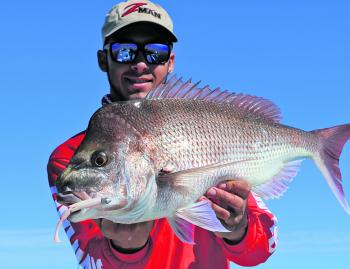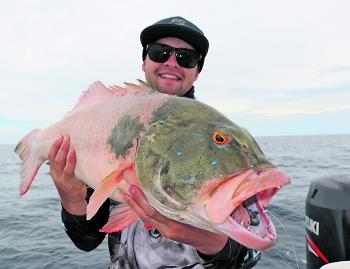Ex-tropical cyclone Debbie has definitely stirred up the waters on the Fraser coast, with minor flooding in all localised creeks and moderate flooding in the main Mary River system. Similar reports came from the Burrum system as Lenthalls Dam was reportedly going over by 1m. This may see significant numbers of freshwater barra being flushed out into the salt and replenishing stocks.
For some this can be seen as a blessing and others a curse. Due to the hard work of the fish stocking association, Lake Lenthalls has recently bounced back and anglers have been reliving the fishery’s glory days (like back before the dam wall was raised). Anglers described the surface bite as the best they have seen in a decade. Only time and receding water levels will give us an indication as to how many bass and barra were lost in the floodwaters.
As mentioned above, all our main river systems have received sufficient water flow to give them a long anticipated flush or clean out. This will push large quantities of bait in the form of herring, mullet and prawns out too sea, which should see them congregating around the river mouths where there is a greater salinity level.
In turn, predatory fish like barra, threadfin salmon and grunter will push down stream, often assembling in large numbers as they gorge themselves on the masses of tightly congregated bait. Focus points to target are going to be the many rock bars and outcrops, newly established structures in the form of tree lay downs, the vast flats and adjacent areas. Tactics of choice for the avid lure angler will be to go bright or noisy. If you want to cast and retrieve hardbodies, you can, but soft vibes are another very effective option.
Other areas to focus on are going to be the less affected creeks on the western side of Fraser Island and the Great Sandy Straits. These substantially smaller creek systems are less affected by floodwaters. A good flush will see the bait on the move and predatory fish actively feeding. Grunter will be a particularly keen target species in and around these areas as they scavenger feed.
Deeper ledge country like Ungowa, which runs parallel down the western side of Fraser will be great options to flick a lure or soak a live bait. Areas like these will be holding large quantities of bait. Expect to tangle with species such as mulloway, barra, grunter, mangrove jack and cod.
Local beaches have seen more summer whiting this season than previous years with water temperatures exceeding 30°C in the shallows. After recent rains and this major influx of freshwater coinciding with some strong southeasterly winds, water temperatures should drop quite dramatically. This will hopefully see those bigger schools of summer whiting schooling back on the beach front. The main areas to focus on will be around the first channel of the Urangan Pier and the two rock groins where the storm water outlet runs out.
Localised flooding would have seen these outlets flowing relatively hard and all forms of nutrient rich foods such as worms, crickets, shrimp and small baitfish would have been washed out. Species like the summer whiting will take full advantage of this and school out in front of the pipes waiting for an easy feed around the top of the tide.
Scavenger feeders like the yellowfin bream will be on the cards and worth targeting. They will have been flushed out of the upper reaches of the river and creek systems, making river mouths and adjacent flats likely areas to target them.
Soft plastics are a very effective technique when targeting bream and a proven performer. Another great option if waters are exceptionally dirty is a smaller 1/6 or 1/4oz TT Switchblade. Lures that emit large amounts of vibration through the water will aid in species detecting the lure. Don’t be surprised if you pick up flathead or even a grunter as by-catch.
We have enjoyed a remarkable fishery inshore this year with incredible numbers of coral trout, coral bream and cod being caught. This will start to slow down as water temperatures drop and we will see many of these species moving back out onto the deeper reefs and wrecks.
There have been good reports of early season snapper making their way onto our inshore reefs and ledges. Don’t be put off by the dirty water. Snapper will often feed into the fringes of the dirty water lines as these are great bait congregation points. The best practice for targeting snapper will be the usual dawn and dusk bites preferably coinciding with a tide change.
Snapper respond well to artificial lures in the form of soft vibes and plastics. If the fish are scarce, trolling with deeper 20m+ diving hardbodies will be very effective and allow you to cover more ground. Hot lures in the past have been the Classic Dr Evil in purple mullet or the Zerek Ripper Diver 130mm in colour 10.
Don’t be fooled by the dirty water. You can still expect to find both mac tuna and longtail tuna in and around the inshore islands and the main shipping channels, as they feed on the large quantities of bait in and around the dirty water lines. If the weather permits and you can run up to the island from around Coongul Creek north to Platypus Bay, there have still been massive schools of mac and longtail tuna with the odd big spotties turning up.
With limited conditions for boaties, there have been very few reports from the offshore reef systems and out over the other side of the Breaksea Spit. In saying that, if you do manage to score a break in the weather, these areas are going to be worth the run as this time of year is when the deeper reefs begin to fire up.
For the first time in many years the famous Hervey Bay flats fishery has come back to life with catches such as the renowned golden trevally, queenies, giant herring and GTs being landed. Prior to the rain catches were frequent on both fly and lure. We are yet to see how they react to the influx of fresh water and if the floodwaters reach the flats.
For crabbers, the long awaited rains will see the crabs up and on the move. The main river and creek systems will be out of action for a short period. Your best efforts should be focused down around the lower reaches of the systems, river mouths and adjacent flats. Smaller less affected creek systems like those on the western side of Fraser will be worth a look.
Don’t go anywhere without a cast net for the next few months, if you’re fishing any of the local rivers or creeks, as prawns will be on the move. Searching for the right water quality will see the greatest results. Target areas like the lower reaches of our rivers and creek systems or down the straits. Most of the prawns would have been pushed out.
Smaller prawns will be found around the drain mouths, flats and associated areas. They grow relatively quickly and with ample food for them now it will only be a matter of weeks before they reach a good size. As water quality improves expect to see a burst down the straits and the lower reaches of the Mary River system.
As we move into another season and the water quality begins to improve we will see some very exciting fishing here on the Fraser Coast, with good catches of snapper, grunter and bream. If weather permits then the wider reefs are going to fire for a host of different species, so buckle in.
| • This report was compiled by the team at Fishermans Corner in Hervey Bay. For more information on what’s biting, and where and how to catch them on the fantastic Fraser Coast, drop in and see the crew at Fishermans Corner 59 Torquay Rd, Hervey Bay or give them a call on | (07) 4128 1022. |
|---|

The author with a school size longtail tuna, which was fooled by a small baitfish imitation fly.

Snapper are suckers for a well presented soft plastic. The author caught this school size fish on a ZMan 5” PaddlerZ in coconut ice.

Corey Abood’s PB bar-cheek trout weighing in at 7kg, which he muscled on a recent trip with the author fishing the wider reefs off Hervey Bay.




